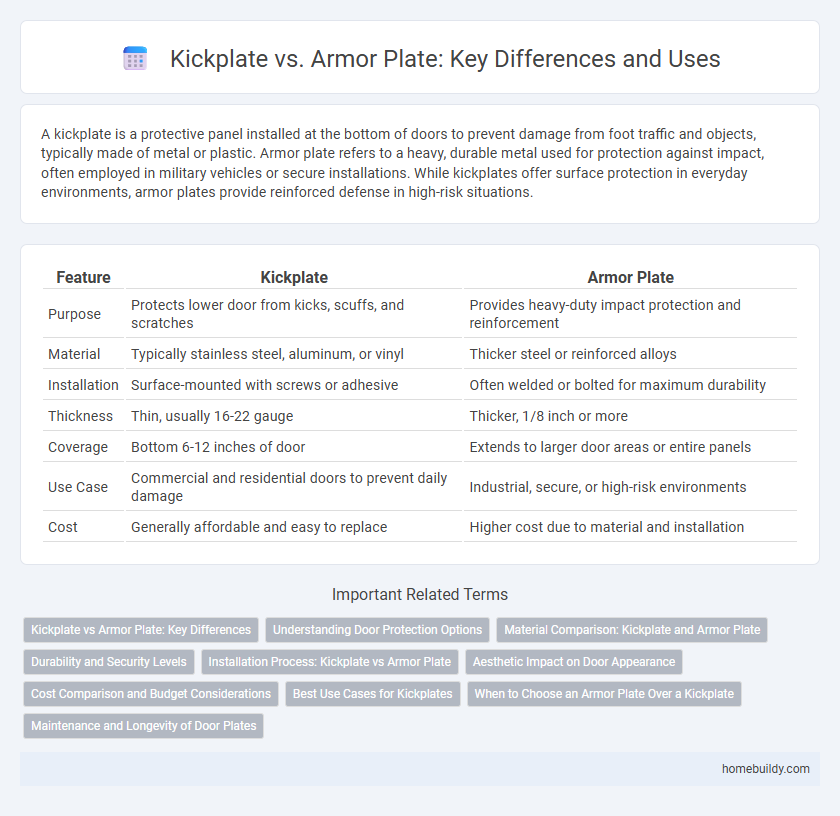A kickplate is a protective panel installed at the bottom of doors to prevent damage from foot traffic and objects, typically made of metal or plastic. Armor plate refers to a heavy, durable metal used for protection against impact, often employed in military vehicles or secure installations. While kickplates offer surface protection in everyday environments, armor plates provide reinforced defense in high-risk situations.
Table of Comparison
| Feature | Kickplate | Armor Plate |
|---|---|---|
| Purpose | Protects lower door from kicks, scuffs, and scratches | Provides heavy-duty impact protection and reinforcement |
| Material | Typically stainless steel, aluminum, or vinyl | Thicker steel or reinforced alloys |
| Installation | Surface-mounted with screws or adhesive | Often welded or bolted for maximum durability |
| Thickness | Thin, usually 16-22 gauge | Thicker, 1/8 inch or more |
| Coverage | Bottom 6-12 inches of door | Extends to larger door areas or entire panels |
| Use Case | Commercial and residential doors to prevent daily damage | Industrial, secure, or high-risk environments |
| Cost | Generally affordable and easy to replace | Higher cost due to material and installation |
Kickplate vs Armor Plate: Key Differences
Kickplates are typically installed at the bottom of doors to protect against damage from foot traffic and equipment, made from materials like stainless steel or aluminum for durability and corrosion resistance. Armor plates, in contrast, provide enhanced protection against impact or forced entry and are often thicker, heavier, and designed for security purposes in high-traffic or vulnerable areas. While kickplates focus on preventing wear and cosmetic damage, armor plates prioritize structural reinforcement and resistance to break-ins or severe impacts.
Understanding Door Protection Options
Kickplates provide essential protection to lower door sections from scuffs and impacts, typically made of thin metal or plastic. Armor plates offer heavier-duty reinforcement, designed to enhance security by preventing forced entry and resisting more significant damage. Selecting between kickplates and armor plates depends on the level of durability and security required for specific door protection needs.
Material Comparison: Kickplate and Armor Plate
Kickplates are typically made from lightweight materials like aluminum or stainless steel, designed to protect door surfaces from scuffs and minor impacts. Armor plates, constructed from thicker, heavy-duty metals such as steel or reinforced composites, offer enhanced durability and resistance against strong physical force or penetration. Choosing between kickplate and armor plate depends on the level of protection needed, with kickplates ideal for everyday wear and armor plates suited for high-security applications.
Durability and Security Levels
Kickplates are designed primarily to protect the lower portion of a door from impact and wear, offering moderate durability suitable for residential and light commercial use. Armor plates provide enhanced security and durability, constructed from heavier gauges of steel or reinforced materials to resist forced entry and high-impact damage. The higher thickness and robust construction of armor plates significantly improve protection against break-ins compared to standard kickplates.
Installation Process: Kickplate vs Armor Plate
Kickplates are typically easier to install, requiring only basic tools such as screws and a drill, with minimal alignment needed due to their standardized sizes. Armor plates, designed for heavier protection, often involve more complex installation procedures, including precise measurements, reinforced mounting hardware, and sometimes professional fitting to ensure structural integrity. The installation process for kickplates prioritizes quick application and aesthetic consistency, while armor plates focus on durability and enhanced security, demanding a more meticulous setup.
Aesthetic Impact on Door Appearance
Kickplates provide a subtle protection and enhance door aesthetics by blending seamlessly with various styles and finishes, preserving the overall design integrity. Armor plates, typically thicker and more industrial, emphasize durability over visual appeal, often altering the door's appearance with a heavy-duty look. Choosing between a kickplate and an armor plate depends on balancing aesthetic preferences and protective requirements for the door's environment.
Cost Comparison and Budget Considerations
Kickplates generally offer a more cost-effective solution compared to armor plates, making them suitable for budget-conscious projects. While kickplates provide adequate protection against scuffs and minor impacts, armor plates feature enhanced durability but come at a higher price point due to their heavy-duty materials. Careful evaluation of the required protection level and project budget ensures proper allocation of funds between affordable kickplates and premium armor plates.
Best Use Cases for Kickplates
Kickplates are best suited for interior doors in high-traffic areas where protection from scuffs, scratches, and minor impacts is needed without adding heavy-duty reinforcement. They effectively guard against damage caused by door kicks and carts, making them ideal for offices, schools, and residential settings. Unlike armor plates, kickplates provide a balance between durability and aesthetic appeal, perfect for environments requiring moderate protection.
When to Choose an Armor Plate Over a Kickplate
Choose an armor plate over a kickplate when protection against heavy impact, such as from machinery, forklifts, or severe vandalism, is required. Armor plates are made from thicker, more durable materials like stainless steel or heavy gauge aluminum, providing superior resistance to dents and penetration compared to standard kickplates. For environments with high traffic and risk of substantial damage, armor plates ensure enhanced door durability and extended lifespan.
Maintenance and Longevity of Door Plates
Kickplates, typically made of stainless steel or aluminum, require minimal maintenance due to their rust-resistant properties and simple cleaning needs, enhancing door plate longevity in everyday environments. Armor plates, often constructed from heavier-duty materials like galvanized steel, provide superior impact resistance and durability, reducing the frequency of repairs or replacements in high-traffic or industrial settings. Choosing between kickplates and armor plates depends on balancing ease of upkeep with the expected level of protection and wear over time.
Kickplate vs armor plate Infographic

 homebuildy.com
homebuildy.com